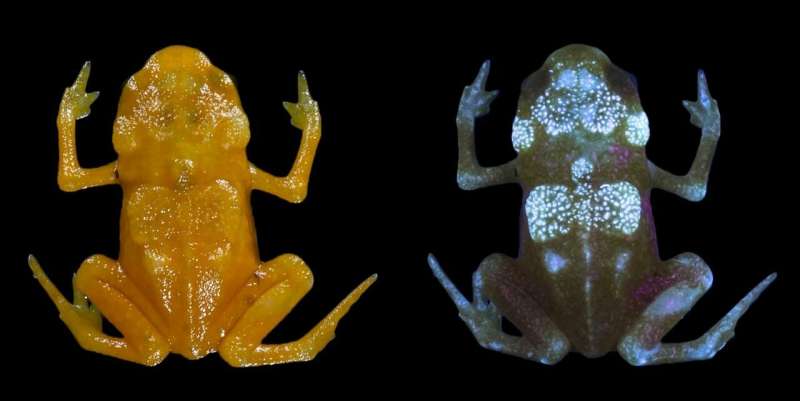Fluorescence discovered in tiny Brazilian frogs

An international team of researchers led by NYU Abu Dhabi Postdoctoral Associate Sandra Goutte was studying the acoustic communications of these miniature frogs. When they discovered that Brachycephalus ephippium could not hear its own mating calls, they searched for alternative visual signals the frogs could use to communicate instead. Unexpectedly, when they shone an ultra-violet (UV) lamp on the frogs, their backs and heads glowed intensely.
"The fluorescent patterns are only visible to the human eye under a UV lamp. In nature, if they were visible to other animals, they could be used as intra-specific communication signals or as reinforcement of their aposematic coloration, warning potential predators of their toxicity," says Sandra Goutte.
Pumpkin toadlets (also called Brachycephalus ephippium) are tiny, brightly-colored, and poisonous frogs that can be found in the Brazilian Atlantic forest. During the mating season, they can be seen by day walking around the forest and producing soft buzzing calls in search of a mate.
An international team of researchers led by NYU Abu Dhabi Postdoctoral Associate Sandra Goutte was studying the acoustic communications of these miniature frogs. When they discovered that Brachycephalus ephippium could not hear its own mating calls, they searched for alternative visual signals the frogs could use to communicate instead. Unexpectedly, when they shone an ultra-violet (UV) lamp on the frogs, their backs and heads glowed intensely.
In a new paper published in the journal Scientific Reports, the researchers report that fluorescent patterns are created by bony plates lying directly beneath a very thin skin. In fact, the toadlet's entire skeleton is highly fluorescent, but the fluorescence is only externally visible where the layer of skin tissue over the bones is very thin (about seven micrometers thick). The lack of dark skin pigment cells (which block the passage of light) and the thinness of the skin allow the ultraviolet light to pass through and excite the fluorescence of the bony plates of the skull. The fluorescent light is then reflected back from the frog's bone, and can be seen as bluish-white markings by the observer if they have a UV lamp.
"The fluorescent patterns are only visible to the human eye under a UV lamp. In nature, if they were visible to other animals, they could be used as intra-specific communication signals or as reinforcement of their aposematic coloration, warning potential predators of their toxicity," said Goutte. "However, more research on the behavior of these frogs and their predators is needed to pinpoint the potential function of this unique luminescence."
The researchers compared the skeletons of the two species of pumpkin toadlets to closely related, non-fluorescent species. The pumpkin toadlets' bones proved to be much more fluorescent. Pumpkin toadlets are diurnal, and in their natural habitat, the UV or near-UV components of daylight might be able to create fluorescence at a level detectable by certain species.
More information: Scientific Reports (2019). DOI: 10.1038/s41598-019-41959-8 , www.nature.com/articles/s41598-019-41959-8
Journal information: Scientific Reports
Provided by New York University




















